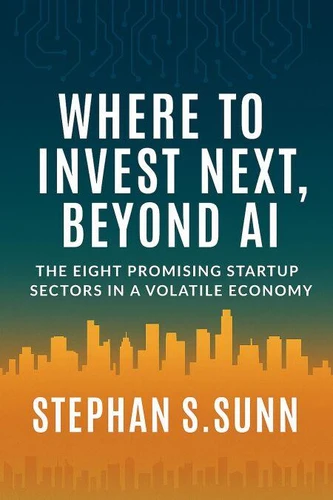Nouveauté
Where to Invest Next, Besides AI
Par :Formats :
Actuellement indisponible
Cet article est actuellement indisponible, il ne peut pas être commandé sur notre site pour le moment. Nous vous invitons à vous inscrire à l'alerte disponibilité, vous recevrez un e-mail dès que cet ouvrage sera à nouveau disponible.
Disponible dans votre compte client Decitre ou Furet du Nord dès validation de votre commande. Le format ePub est :
- Compatible avec une lecture sur My Vivlio (smartphone, tablette, ordinateur)
- Compatible avec une lecture sur liseuses Vivlio
- Pour les liseuses autres que Vivlio, vous devez utiliser le logiciel Adobe Digital Edition. Non compatible avec la lecture sur les liseuses Kindle, Remarkable et Sony
 , qui est-ce ?
, qui est-ce ?Notre partenaire de plateforme de lecture numérique où vous retrouverez l'ensemble de vos ebooks gratuitement
Pour en savoir plus sur nos ebooks, consultez notre aide en ligne ici
- FormatePub
- ISBN8232479473
- EAN9798232479473
- Date de parution20/10/2025
- Protection num.pas de protection
- Infos supplémentairesepub
- ÉditeurHamza elmir
Résumé
The book identifies eight high-potential startup sectors poised to thrive in today's volatile economy, moving beyond AI to focus on resilience and strategic innovation. Key themes include policy-first approaches, climate-resilient infrastructure, next-gen manufacturing, and trade policy arbitrage. Startups that integrate regulatory foresight, localized supply chains, and deep tech (e.g., synthetic biology, space tech) are outperforming traditional models.
The author emphasizes the importance of aligning with geopolitical shifts, such as India's PLI schemes or the EU's Green Deal, to capture first-mover advantages. Notable sectors include aging economy innovations (robotics, longevity biotech, senior fintech) and vertical B2B marketplaces, which leverage industry-specific expertise to solve acute pain points. The book also highlights defense tech's commercial spinoffs, where dual-use technologies bridge national security and private-sector applications.
A recurring insight is the need for startups to combine policy tailwinds, technological breakthroughs, and market urgency to build defensible moats. The concluding roadmap offers a strategic scorecard to evaluate sectors based on policy support, capital efficiency, and exit pathways. The author advises founders and investors to prioritize timing, avoid overheated markets, and align ventures with their unique advantages-whether domain expertise or cultural agility.
In a world of uncertainty, the book champions ventures that stack multiple forces (policy, tech, timing) to create asymmetric growth opportunities beyond fleeting trends.
The author emphasizes the importance of aligning with geopolitical shifts, such as India's PLI schemes or the EU's Green Deal, to capture first-mover advantages. Notable sectors include aging economy innovations (robotics, longevity biotech, senior fintech) and vertical B2B marketplaces, which leverage industry-specific expertise to solve acute pain points. The book also highlights defense tech's commercial spinoffs, where dual-use technologies bridge national security and private-sector applications.
A recurring insight is the need for startups to combine policy tailwinds, technological breakthroughs, and market urgency to build defensible moats. The concluding roadmap offers a strategic scorecard to evaluate sectors based on policy support, capital efficiency, and exit pathways. The author advises founders and investors to prioritize timing, avoid overheated markets, and align ventures with their unique advantages-whether domain expertise or cultural agility.
In a world of uncertainty, the book champions ventures that stack multiple forces (policy, tech, timing) to create asymmetric growth opportunities beyond fleeting trends.
The book identifies eight high-potential startup sectors poised to thrive in today's volatile economy, moving beyond AI to focus on resilience and strategic innovation. Key themes include policy-first approaches, climate-resilient infrastructure, next-gen manufacturing, and trade policy arbitrage. Startups that integrate regulatory foresight, localized supply chains, and deep tech (e.g., synthetic biology, space tech) are outperforming traditional models.
The author emphasizes the importance of aligning with geopolitical shifts, such as India's PLI schemes or the EU's Green Deal, to capture first-mover advantages. Notable sectors include aging economy innovations (robotics, longevity biotech, senior fintech) and vertical B2B marketplaces, which leverage industry-specific expertise to solve acute pain points. The book also highlights defense tech's commercial spinoffs, where dual-use technologies bridge national security and private-sector applications.
A recurring insight is the need for startups to combine policy tailwinds, technological breakthroughs, and market urgency to build defensible moats. The concluding roadmap offers a strategic scorecard to evaluate sectors based on policy support, capital efficiency, and exit pathways. The author advises founders and investors to prioritize timing, avoid overheated markets, and align ventures with their unique advantages-whether domain expertise or cultural agility.
In a world of uncertainty, the book champions ventures that stack multiple forces (policy, tech, timing) to create asymmetric growth opportunities beyond fleeting trends.
The author emphasizes the importance of aligning with geopolitical shifts, such as India's PLI schemes or the EU's Green Deal, to capture first-mover advantages. Notable sectors include aging economy innovations (robotics, longevity biotech, senior fintech) and vertical B2B marketplaces, which leverage industry-specific expertise to solve acute pain points. The book also highlights defense tech's commercial spinoffs, where dual-use technologies bridge national security and private-sector applications.
A recurring insight is the need for startups to combine policy tailwinds, technological breakthroughs, and market urgency to build defensible moats. The concluding roadmap offers a strategic scorecard to evaluate sectors based on policy support, capital efficiency, and exit pathways. The author advises founders and investors to prioritize timing, avoid overheated markets, and align ventures with their unique advantages-whether domain expertise or cultural agility.
In a world of uncertainty, the book champions ventures that stack multiple forces (policy, tech, timing) to create asymmetric growth opportunities beyond fleeting trends.



